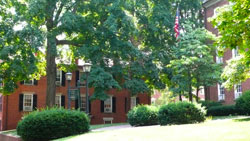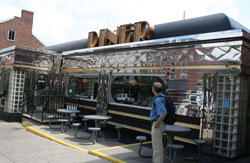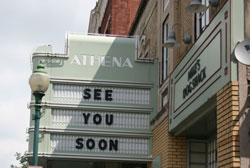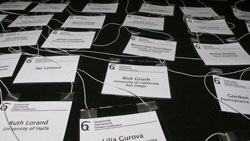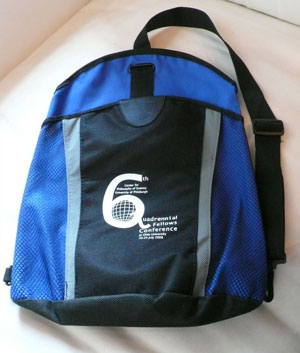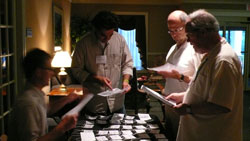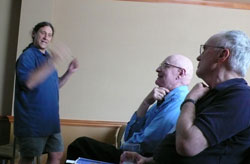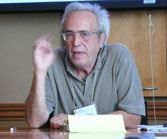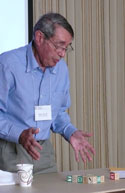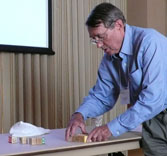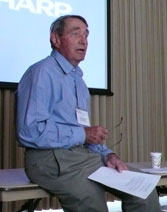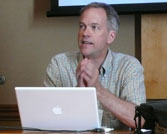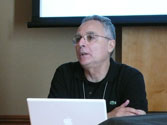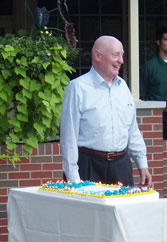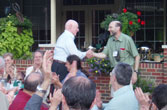

![]()
::: postdoc fellowships
::: senior fellowships
::: resident fellowships
::: associateships
![]()
being here
::: visiting
::: the last donut
::: photo album
::: center home >> being here >> last donut? >> 20-24 july2008 |
Sunday-Thursday, 20-24 July 2008 Sixth Quadrennial Fellows Conference Every four years, the past Fellows of the Center for Philosophy of Science gather in a reunion conference. It was a whimsical idea that started with a small event long ago and grew to a beloved institution. This is when Fellows can spend leisurely and thoughtful time with old friends from their year at the Center. They can also make and remake connections with Fellows from other years to form the cross linkages that keeps our community so solid. It is a time of nostalgia, happiness and joviality; and some very serious philosophy of science. Recent conferences have been in Poland, Patagonia and Italy and now finally the latest in the series has come. Planning had begun almost the moment I stepped into the director's office over two and half years ago in January 2006. After much discussion and some site visits, we had settled on Ohio University in Athens, Ohio, a mere three hours drive from Pittsburgh. The thought was that this was the first reunion conference to be held in the US, which would make it much easier for US Fellows to attend.
Between that conception and the reality of today's conference there was a lot of planning by our Center staff (Joyce, Karen, Carol and Peter) and our opposite numbers in Ohio. Phil Ehrlich, a past Fellow, and Wendy Parker, a Pitt HPS doctorate, became the local organizing committee in Ohio and Art Zucker, Ohio University's chair of the Philosophy Department, became what he liked to call a "consultant" who mediated between us and the university. Most participants were either driving or flying into Columbus airport, one and a half hours drive from Athens. Peter Gildenhuys had patiently orchestrated their arrival times to match the few shuttle buses and rides that we could arrange for the trip. He also drove a hearty band of twelve of us in a Pitt university van from Pittsburgh. We arrived, tired and weary, after the first batches of Fellows were already in the hotel, milling around the reception desk. That was the moment when the conference first seemed real. Here were fellows from many years all congregating in the hotel lobby turning to us, expectantly. Peter and I hurried in and began setting up our registration desk. We laid out the name tags, programs and maps and began to hand our the little bags with the conference logo that we'd prepared especially for the conference. There was no time to think. Three of our fellows had been stranded by bad weather on the East Coast and were arriving at odd times and a fourth had been delayed by visa complications. We'd been fielding phone calls on our cell phones during the drive and now started to figure out just how we could get our lost colleagues from Columbus to Athens. We lost speakers from one session and had to shoe-horn them into others. These were complications that slowly resolved over the next day and are soon forgotten. As we handed out the nametags and bags, the conference made its transition from the potential of our list to the actuality of a real collection of people. There are two basic designs for a conference. One has plenary sessions. Everyone gathers in a single room to hear one speaker at a time. Then there are conferences with parallel session. The conference divides into groups that meet in parallel in separate rooms. With plenary sessions, there a real unity in the event, but there is often little time for each speaker. With parallel sessions, the participants are fragmented, but there is as much time available for speakers as we are willing to fragment the conference. How should this event be organized? When we planned for the &HPS1 conference of last year, the organizing committee had been adamant that there be plenary sessions only; and I thought the conference benefited greatly from that insistence. However this conference has far too many speakers for an all plenary conference, unless speakers were willing to settle for very short time slots. Which should we choose? It was not an easy question to answer. But then why did we need to choose? A delicious experiment hovered before us. What if we simply asked participants to choose? Then everyone would get what they wanted. So, in our preparatory emails, we asked participants to nominate whether they would speak in a 20 minute plenary session or a 50 minute parallel session. We had done the arithmetic, so we knew we could expand and contract the plenary and parallel sessions to accommodate all distributions of answers. How would participants choose? I had developed my own expectations. I felt that the trade off was clear. I'd rather give a shorter talk to a larger audience. While I love my academic projects down to their very last detail, I think I can probably tell an audience as much as they really want to hear of each in 20 minutes, with a few minutes left for questions. My inclination was that most others would feel the same. Informal polling in the corridors, however, suggested that might not be right. As the responses came in, it became clear that parallel sessions with longer times were overwhelmingly favored. I began to ask sporadically why a participant preferred the longer, parallel slot. The reactions were typically hesitant. At first there was a little surprise at the question. I could not tell if it was because they hadn't really thought about it; or if they did not want to embarrass me by pointing out the completely obvious answer. And that answer was almost uniformly that their project is just too big to boil down into a mere 20 minutes. As I sit now in the Ohio Inn and the end of the first day, I am tired and warmed. I am tired from the efforts of organizing an event of this size. And I am warmed by the chance to meet Fellows I had gotten to know well during their visits before they departed for their homes, leaving us an empty office. And it was gratifying to see Fellows from past years reacquaint and Fellows from different years introduce themselves. Sometimes a the little light comes on. "Oh, you're Ron Giere!"
The scheduling was tight. There was barely time to clear away the computer from which Phil had projected his visuals before our next speaker, Storrs McCall, began the paper in which he promised to prove the consistency of arithmetic. Storrs knew full well that he was what used to be known as a "paradoxer," one who demonstrates impossible things, such as how to square the circle. Establishing the impossibility of this proof of the consistency of arithmetic was one of the signal achievements of 20th century logic that sprung from the mind of the great Kurt Goedel. I'd run into Storrs a few weeks before in Montreal and nervously inquired if he really was going to do what his talk title said. He beamed and foreshadowed his secret weapon--it would be a "semantic" proof, one based on models. He began to explain, saying just enough for me to know that it would take more of a logician than I am to penetrate its secret. So I looked forward to the unveiling of the secret. It came a few minutes into the talk when Storrs spilled his "model" out onto the table. It was a set of children's blocks. These, and any other finite set of blocks, were his models, whose existence automatically proved the consistency of arithmetic. As his story unfolded, there were new rules and I joined with the rest of the room trying to discern just how this new game was to be played. Storrs cheerfully and artfully batted away our worries as they spontaneously arced towards his place at the front of the room, until, suddenly, his time was gone. We left him, besieged at the podium with final questions. The day proceeded. It was time for me to hear some philosophy of biology. It is not my home topic, but the titles and abstracts were too tempting to resist. So I passed the rest of day hearing a masterful presentation from Ken Waters on just how the DNA revolution had transformed modern biological practice; and then an account from Giovanni Camardi on how a synthesis of ideas from information and computation theory might just tame the bewildering plethora a data pouring out of the human genome program. It is the end of the first day. I am already looking forward to our closing banquet. The conference coincides with Nick Rescher's 80th birthday. I will need to figure out just how to raise the topic of his birthday at the banquet and find a way to express to him our communal affection and respect. He is our teacher, our support and our friend. Then, before we get too serious, we'll produce the cake with 80 candles. Tomorrow we shall hear some more talks in the morning. Then the afternoon will be given over to a conference tradition, the excursion. This time we will have an outdoor picnic, take a walk to see the famed Ash Cave and then end in a leisurely canoe trip down the river. They are forecasting rain for the afternoon. But since they also forecast a high temperature of 85F, I am not so worried. If we are rained on, it will be a cooling relief. As I have learned to say very often at these events, let's deal with that problem when it actually happens.
John D. Norton |
